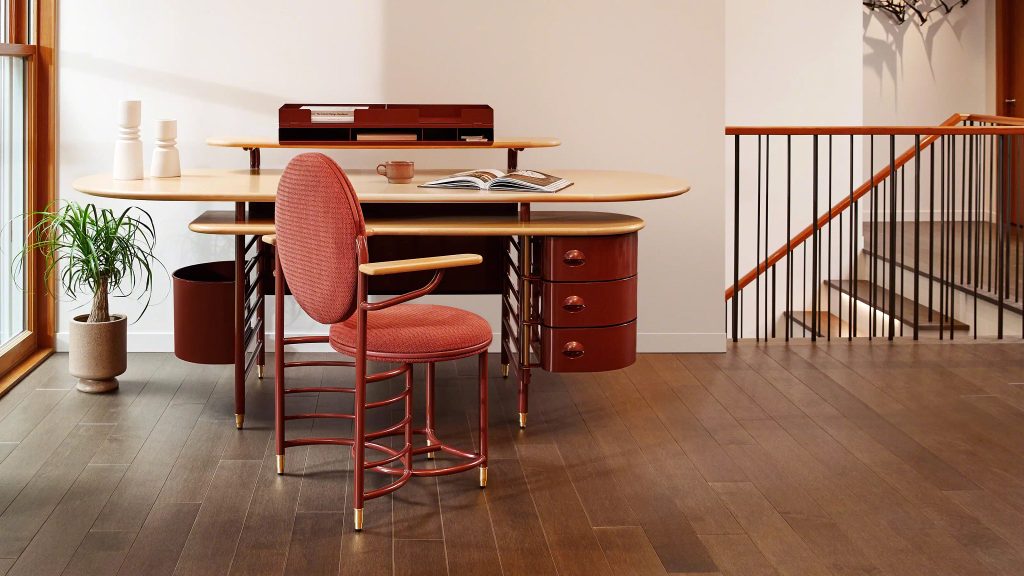Steelcase Collaborates on Furniture With The Frank Lloyd Wright Foundation
The new desks, tables and chairs of the Racine Collection reinterpret some of the beloved architect’s classic designs

It’s been a milestone few months for the legacy of architect and designer Frank Lloyd Wright, from the meticulous restoration of Fawcett Farm House to the mind-bending digital depictions of some of his unbuilt plans. Now, American furniture manufacturer Steelcase debuts their Racine Collection, designed in collaboration with the Frank Lloyd Wright Foundation. The tiered desks, utility tables and lounge chairs within the series are not reproductions (though they reference archival works); rather they’re contemporary pieces with evolved proportions, high-performance fabrics and materials and tweaks that enhance use and comfort. Of greatest importance, they don’t feel like museum pieces. They’re meant to be engaged with.

Regarding the collaboration, Stuart Graff, the President and CEO of the Frank Lloyd Wright Foundation (which maintains an office in one of Scottsdale‘s architectural masterpieces, Taliesin West), tells COOL HUNTING, “Wright established the foundation back in 1940 for the purpose of perpetuating his ideas about organic architecture and design. Organic architecture can sometimes be summarized as ‘of its time and place, for its time and place,’ so it cannot be locked in the past. It has to be for the present and the future. That’s the nature of this partnership: how we can take our historical work and all the principles that underlie it and bring it to how we live and work today.”

Meghan Dean, the General Manager for Partnerships at Steelcase, nods to their historic relationship with the architect. “Frank Lloyd Wright is part of our cultural heritage,” she tells us. “In 1938, for installation in 1939, the Johnson family came to Steelcase—which at the time was called the Metal Office Furniture Company—to manufacture the Wright-designed office furniture for their SC Johnson administration building in Racine, Wisconsin.” It’s this collection that informs the new line, and Steelcase keeps an original desk in their Grand Rapids, Michigan archive, which we were able to observe alongside the new pieces at their Columbus Circle office in NYC. The Art Institute of Chicago has one of the original desks, as does MoMA and several other museums.

“At the time, this was incredibly novel and forward-thinking in terms of how user-centric it was,” Dean continues. “Wright really learned what the users of the desk were doing for their daily tasks. There were tons of iterations—some with big cut-outs for ‘comptometers’ for the job category of Comptometer Operator.” This is only part of Steelcase’s interwoven history with Wright. In 1985, the brand purchased Wright’s Meyer May House, a 1908 Prairie School-style residence in Grand Rapids. They led a monumental two-year restoration and ultimately opened it to the public. It’s now free to visit three days each week. For Steelcase employees, it’s also an immersion into organic architecture.

Two years ago, the opportunity came up to dig deeper into the relationship. “One of our shared objectives was a lack of interest in making reproductions,” Dean says. Rather, Steelcase and the foundation wanted to translate Wright’s values for a contemporary market. “He was so forward-thinking in everything he did. If he had access to modern technologies like 3D printers and LED lighting, or anything we take for granted, he would have used them. We asked ourselves, ‘How can we take his archive and reimagine, reinterpret and reintroduce?'”
There is this permission to stretch the boundaries and push the limits and bring something new in
The foundation’s licensing program dates back to 1955 and Wright himself entered into license agreements to democratize his design. “Part of the way we carry out our mission of educating architects and designers is to take historical references and also statements about design principles and put them in the hands of new best-in-class designers,” Grand says. “That’s how our conversation began with Steelcase. We wanted a generation of young designers to use these ideas. There is this permission to stretch the boundaries and push the limits and bring something new in.”

One notable influence moving forward will be color. “A lot of times people think about Frank Lloyd Wright’s colors being the colors of the Prairie School, these rusts and greens.” Graff says. “In fact, he used a broad selection of color—all of it derived from nature, but there were surprises. When Wright died, someone had the foresight to take a photograph of every pencil in his drawer. The color palette that we are working with for all our Steelcase products is the color palette that Wright worked with through all of his career, found in his own sketches and drawings.” Beyond this one surprising image, there are more than 1.3 million entries in the Frank Lloyd Wright archives to reference.

“This is an expansive, long-term relationship that will hopefully go many years into the future and cover all furniture typologies,” Dean says of the partnership. “We’re already working on elements for the living room and dining room and throughout the home. Our textile company, Designtex, is launching their first Frank Lloyd Wright textile and wall covering collection later this year.”
Graff alludes to many surprises ahead. “Everybody knows the Prairie School years,” he says. “The Prairie School ends about 1915. Wright worked for another 45 years—designing things like Fallingwater, the Guggenheim Museum, the Imperial Hotel and more. This allows us to pull hidden gems: furniture, furnishings and houses with beautiful design elements that just aren’t known. We can pull out the unexpected that we think deserves some attention because of its ability to be responsive to how we live today.” Already, the Racine Collection meets tangible needs in nuanced ways not found in other contemporary designs.
Hero image courtesy of Steelcase












